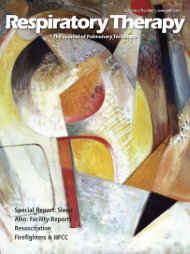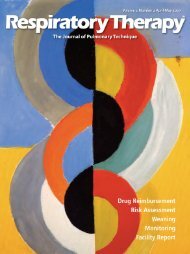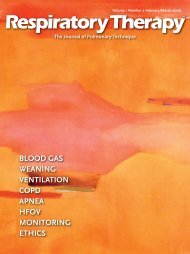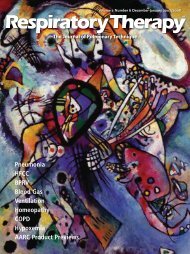RT 02-03 JJ07 main web - Respiratory Therapy Website
RT 02-03 JJ07 main web - Respiratory Therapy Website
RT 02-03 JJ07 main web - Respiratory Therapy Website
You also want an ePaper? Increase the reach of your titles
YUMPU automatically turns print PDFs into web optimized ePapers that Google loves.
abnormally thick, tenacious mucus. Without assistive<br />
interventions, CF patients suffer frequent, severe infections,<br />
rapid lung deterioration and early death. Striking improvements<br />
in PFT stability, general health and survival among CF patients<br />
have encouraged physicians to prescribe HFCC for patients with<br />
any condition characterized by MCC impairment such as<br />
bronchiectasis, chronic bronchitis and dyskinetic ciliary<br />
disorders. 30,58-61 HFCC therapy has been prescribed to manage<br />
lung problems tied specifically to inhaled UFP, most notably in<br />
coal miners with pneumoconiosis associated with coal dust<br />
exposure.<br />
The inCourage PAC<br />
For exposed firefighters, prompt on-site or routine post-shift infirehouse<br />
removal of inhaled UFP may be a more practical<br />
intervention. A new HCFF device, the inCourage PAC (Portable<br />
Airway Clearance), has been designed specifically to meet<br />
emergency airway clearance needs and ongoing <strong>main</strong>tenance<br />
therapy. HFCC with the inCourag PAC is easy to administer and<br />
can be performed in any setting with access to a power source.<br />
Users secure an inflatable wrap-like garment over their chest<br />
and connect two tubes to both the garment and a pulsating<br />
therapy unit (PTU). When activated, rapid compressions of the<br />
chest wall produce oscillations within the airways that increase<br />
airflow velocities and create brief changes in lung airflow<br />
patterns similar to coughing. Physiological effects are threefold:<br />
1) mucus adherent to bronchial walls is loosened; 62-64 2) thick<br />
secretions are physically altered, thus enhancing clearability 64-66<br />
and; 3) an airflow bias mobilizes particle-laden secretions<br />
toward central airways for elimination by coughing or<br />
expectoration. 62-64,67 Measurements of tracheal mucus clearance<br />
rates (TMCR) show that HFCC increases mucus mobilization up<br />
to 240% of that achieved by healthy MCC systems. 62 Radioactive<br />
tracers attached to carbon particles demonstrate cephalad<br />
movement of mucus from smaller to larger airways. 67 HFCCinduced<br />
interruption of glycoprotein bonds favorably alters<br />
mucus rheology to enhance mucus-mobilizing ciliary activity. 61,<br />
63-66<br />
Up-to-date reviews on the management of fire-associated<br />
inhalation injury routinely advocate airway clearance<br />
interventions to remove both excess mucus and particulate<br />
matter. 68 In its most recent guideline document, the American<br />
Physical <strong>Therapy</strong> Association (APTA) recommends airway<br />
clearance therapy with modalities including mechanical<br />
techniques for chest wall manipulation/percussion/vibration (ie<br />
HFCC) to manage lung problems caused by UFP. 69 The<br />
guidelines include ICD-9 codes for conditions including coal<br />
workers’ pneumoconiosis and other pneumoconioses due to<br />
silica or silicates, due to other inorganic dust, due to other dust,<br />
due to unspecified inhaled matter and due to asbestosis. 69<br />
Anticipated benefits<br />
For firefighters with occupational exposure to byproducts of<br />
combustion, on-site and post shift HFCC treatments may be<br />
expected to:<br />
• improve clearance of particle-laden airway secretions<br />
• enhance cough function<br />
• reduce work of breathing<br />
• improve gas exchange<br />
• increase physical endurance<br />
• enhance health, wellness and fitness<br />
• improve work-related quality of life<br />
• reduce absenteeism and job-related healthcare costs<br />
• reduce risk for long-term lung disease<br />
Summary<br />
Lung function is directly related to lung health; decreasing lung<br />
function is a consistent occupational risk factor among<br />
firefighters and is strongly associated with quality of life<br />
deficits, progressive illness and premature mortality. The health<br />
consequences of overexposure to UFP are clear. Compelling<br />
studies, including WTC disaster-related investigations,<br />
demonstrate the adverse effects of UFP on lung defenses,<br />
mucus production and clearance, and on pulmonary function.<br />
Indisputably, UFP contribute to the development of a broad<br />
range of pulmonary and systemic diseases. Acute and long-term<br />
respiratory damage is prevalent following major fire, explosive,<br />
or industrial disasters. In the light of such evidence,<br />
interventions are urgently needed that will modify the impact of<br />
occupational exposures among firefighters, rescue workers and<br />
civilians. Both basic research and extrapolated clinical<br />
experience support the rationale for firehouse use of HFCC.<br />
Routine use of aggressive airway clearance therapy with the<br />
inCourage PAC may be a simple, reliable and effective way to<br />
reduce risk for occupational lung injury among firefighters.<br />
References<br />
1 Banauch GI, Hall C, Weiden M, Cohen HW, Aldrich TK,<br />
Christodoulou V, Arcentales N, Kelly KJ, Prezant DJ.<br />
Pulmonary function after exposure to the World Trade<br />
Center collapse in the New York City Fire Department. Am J<br />
Respir Crit Care Med. 2006 Aug 1; 174(3):312-319.<br />
2. Herbert R, Moline J, Skloot G, Metzger K, Baron S, Luft B,<br />
Markowitz S, Udasin I, Harrison D, Stein D, Todd A, Enright<br />
P, Stellman JM, Landrigan PJ, Levin SM. The World Trade<br />
Center disaster of the health of workers: five-year<br />
assessment of a unique medical screening program. Environ<br />
Health Perspect. 2006 Dec; 114(12):1853-1858.<br />
3 McClellan, RO. Particle interactions with the respiratory<br />
tract. In: P Gehr and J Heyder, Eds. Particle-Lung<br />
Interactions. [C Lenfant, Executive Editor: Lung Biology in<br />
Health and Disease, Vol 143, Marcel Dekker New York 20<strong>02</strong>].<br />
pp. 3-63.<br />
4 Fireman EM, Lerman Y, Ganor E, Greif J, Fireman-Shoresh<br />
S, Lioy PJ, Banauch GI, Weiden M, Kelly KJ, Prezant DJ.<br />
Induced sputum assessment in New York City firefighters<br />
exposed to World Trade Center dust. Environ Health<br />
Perspect. 2004 Nov; 112(15):1564 - 1569.<br />
5 Moline J, Herbert R, Nguyen N. Health consequences of the<br />
September 11 World Trade Center attacks: a review. Cancer<br />
Invest. 2006 Apr-May; 24(3):294-301.<br />
6 Mauderly JL, Cheng YS, Hoover MD, Yeh, HC. Particles<br />
inhaled in the occupational setting. In: P Gehr and J Heyder,<br />
Eds. Particle-Lung Interactions. [C Lenfant, Executive<br />
Editor: Lung Biology in Health and Disease, Vol. 143, Marcel<br />
Dekker New York 20<strong>02</strong>]. pp. 89-170.<br />
7 Banauch GI, Hall C, Weiden M, Cohen HW, Aldrich TK,<br />
Christodoulou V, Arcentales N, Kelly KJ, Prezant DJ.<br />
Pulmonary function after exposure to the World Trade<br />
Center collapse in the New York City Fire Department. Am J<br />
Respir Crit Care Med. 2006 Aug 1; 174(3):312-319.<br />
8 Lin S, Reibman J, Bowers JA, Hwang SA, Hoerning A, Gomez<br />
MI, Fitzgerald EF. Upper respiratory symptoms and other<br />
health effects among residents living near the World Trade<br />
Center site after September 11, 2001.Am J Epidemiol. 2005<br />
Sep 15; 162(6):499-507.<br />
32 <strong>Respiratory</strong> <strong>Therapy</strong> Vol. 2 No. 3 � June-July 2007











